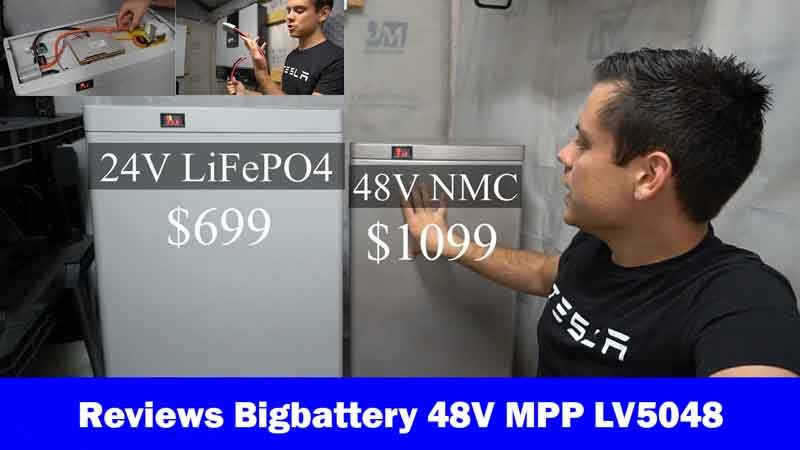Reviews Bigbattery 48V MPP LV5048 Powerful Budget System (Intermediate level) – Bigbattery calm takes used battery modules from various industries. They put it into a box with wheels, they add a battery management system, a voltage meter, and also a circuit breaker.
Reviews Bigbattery 48V MPP LV5048 Powerful Budget System
 | |||
| Chemistry | LiFePO4 (LFP) | Voltage | 48V |
| kWh Capacity | 5.3kWh | Ah Capacity | 115Ah |
| Open Full Specifications | |||
So, this is a ready built battery, and you can configure these in series, in parallel to make a large solar power system, and they work pretty well for people that want to use used batteries, and they do not have experience with battery management systems. This is probably the cheapest plug-and-play option available.

Bigbattery 48V Testing
Today, we’re gonna do a quick comparison of the 24-volt battery which is lithium iron phosphate to their new 48-volt battery which is in MC or nickel manganese coal beta oxide. These are very different batteries with very different characteristics. So, we’re gonna run over some of the different features, and then we’re gonna connect the 48-volt model to an LV5048 inverter.
We’re gonna do a capacity test, and test out some of the features, and make sure that it actually works as advertised, and in my solar shed, I’ve actually used this one for a few months. It’s worked flawlessly. There has never been a single moment where it was not working. So far, this one’s really good and 48-volt batteries are ideal for off-grid solar power systems. You can also take this one, and put it into series to have a 48-volt lithium iron phosphate battery.
Bigbattery 48V Reviews
Reviews Bigbattery 48V MPP LV5048 – So, let’s talk about the differences because these are very different. First, let’s compare the size and the weight for the capacity. Clearly, the battery on the left is wider, and it is taller, and it’s also heavier than the one on the right, but get this the battery on the left has a smaller capacity. It has 3 kilowatt-hours and then the one on the right has 3.8 kilowatt-hours.

So, if size and weight, and space are a consideration for you, then the one on the right is obviously the clear winner.
The next difference is the chemistry. So, on the Left, we have lithium iron phosphate, and on the right we have NMC. The one on the left will last much longer, but we do not have any data on degradation for used batteries. These have been cycled to 60 to 80 percent of their capacity on average. So, it’s hard for me to say long either one will last.
The next thing that considers is what chemistry you plan to build your solar power system. If you already have lead acid or lithium iron phosphate batteries, you cannot and you should not add an NMC battery pack.
I’ve actually experimented personally on this quite a bit with lithium-ion phosphate lithium titanate, and because of the charge and discharge characteristics, or the state of charge is different at different voltages. Even though the nominal voltage is slightly similar, you’re going to run into problems. You will have performance problems, you have longevity problems.
So, lithium iron phosphate cannot be connected in parallel to an NMC battery. So, these batteries have very different applications. If size and weight are an issue, then you should go with this LiFePO4. If you want longevity, you should go with this NMC.
Best Seller
Bigbattery 48V System
Now, let’s build a 48-volt solar power system, and this is the MPP LV 5048. This is a massive 5-kilowatt inverter with an MPPT, and a huge AC charger, and so to connect this to our battery, we need to make our own adapter. So, this is a 50 amp Anderson connector. We have some marine grade 6 gauge wire, and we have some copper lugs.
The next step is connecting the battery to the inverter, but we need to talk about a very crucial step. We need to charge up the inverters capacitors, if you were to connect this battery directly to this inverter, it can either damage the BMS or put it into safe mode. So, to prevent this we’re gonna charge up the capacitors with a small resistor.
So, step one is to connect the positive conductor to the inverter, and now, we can connect the Anderson connector to the battery.

Now, for the final step, you need to be very careful with your safety glasses. We’re gonna charge up the capacitor, so what that means is, we take a 30-ohm resistor connected to the negative conductor, and we just simply want to touch it on the negative terminal of the inverter. That it can charge up the capacitors. So, all we have to do is touch, and now the capacitors are charged.
Now, I’m going to remove the resistor and attach it directly to the inverter, and you’ll notice there was no spark. Now, the battery is connected to the inverter, and we can tighten these nuts down, and then use the insulated wrench to tighten down these terminals.
Now, that the battery is safely connected to the inverter. We can actually turn it on, and if it stays on, that means, you charge up the capacitors properly, and the BMS is not in safe mode. Now, we can actually attach loads and Chargers, and use this all-in-one system.
You can watch all process in this video 🙂
Other Articles Review
- Foldable Solar Suitcase Instruction
- SimpliPhi Lithium Battery Upgrade 81.6kWh
- Solar Generator 2000 watt – Lion Safari ME
- Bluetti AC200 2000W Inverter 700W 145VOC Solar Input
- Review EcoFlow RIVER Pro Portable Power Station




























